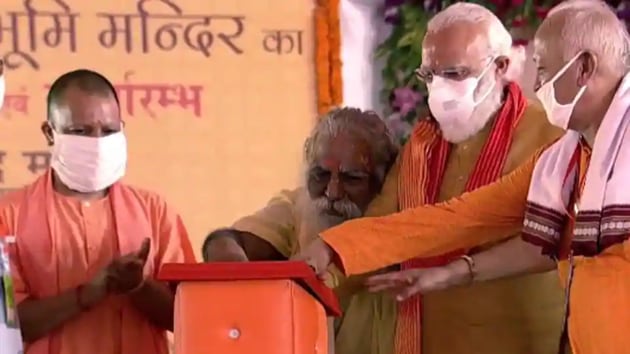Rajasthan govt to legalise mines supplying stone for Ram temple construction in Ayodhya
Banshi Pahadpur forest block, which lies at north-east corner of the wildlife sanctuary, has been in news for its pink sandstone that is transported to Ayodhya for temple construction.
The Rajasthan government has started the process of legalising mining in Banshi Pahadpur area of Bandh Banetha wildlife sanctuary in Bharatpur district from where stones are being sent to Ayodhya for building Ram temple. This comes days after seers in Ayodhya warned the Congress of facing people’s wrath if the supply of stones from Rajasthan slows down.

Prime Minister Narendra Modi participated in the Bhoomi Pujan ceremony for Ram temple in Ayodhya on August 5, 2020, seven months after the Supreme Court resolved the Ram Janambhoomi dispute in Ayodhya and allowed the constructed of the temple. The temple is to be constructed in three years.
The Vishwa Hindu Parishad, which has been sourcing stones from Banshi Pahadpur for some time now, had complained of supply getting stalled because of a crackdown on September 6 and 7 by Bharatpur district administration. The district administration had claimed the stones were being illegally mined from Banshi Pahadpur, a forest block in the north-east corner of the wildlife sanctuary.
“The state government will send a proposal to the ministry of environment and forest (MoEF) by the end of this month for denotification of the forest land to legalise mining there (Banshi Pahadpur). This will provide employment to people and the state will earn revenue,” said additional chief secretary of mines department, Subodh Agarwal.
Also read: Covid-19 - Red tape delays Bihar CM’s Rs 4 lakh ex-gratia to kin of deceased
“The Bharatpur collector is working on the proposal. We should be able to prepare the report in a few days; and then after the state approvals, the proposal will be sent to Centre,” he said.
According to the state mines department, until December 1996, around 42 legal mines of pink, red and yellow sandstone operated in the Banshi Pahadpur forest area. The Supreme Court, by its order on December 12, 1996, prohibited non-forest activities in forest areas without diversion under section 2 of the Forest Act, 1980.
Later when the concept of eco-sensitive zone was introduced, again by the apex court, mining was banned within one km of boundary of wildlife sanctuaries and national parks.
The MoEF mandated environment clearance for mines from June 1, 2016. These developments led to the closure of legal mines in the area but the famous pink stone continued to be mined illegally, said forest officials.
“The pink and yellow sandstone is in high demand. Illegal mining activity in the area feeds processing units in the district. The district administration takes action against illegal mining randomly,” said Bharatpur collector Nathmal Didel.
On September 6-7, joint teams of forest, mines, and police departments seized 27 trucks full of stones. Each of these trucks had 5-8 blocks of stone. “We have sent notices to owners of these trucks as part of process for confiscation under the Rajasthan Forest Act, 1953,” said Mohit Gupta, deputy conservator of forest in Bharatpur. He said the forest produce –the stones in this case – will also be confiscated.
According to mines department officials, each of the blocks seized during the crackdown weighed more than 1,000 kilograms and cost around Rs 50,000 in the local market. Gupta said earlier the department caught tractors during action against illegal mining but the use of trucks to transport stone is a recent phenomenon in this forest area.
Narpat Singh Shekhawat, central joint secretary and Rajasthan president of Vishwa Hindu Parishad, said there is enough stock of the Banshi Pahadpur stone in Ayodhya for building one storey of the temple.
Also read: ‘Malicious actors trying to exploit digital payment platforms’ - NSA Doval
“We will talk to the state government to find a way out if mining activity continues to be hit in Bharatpur,” he said, adding the Ram temple is being built with the sandstone from Banshi Pahadpur because of its unique colour and texture.
The VHP and seers of Ayodhya on Saturday welcomed the Rajasthan government’s decision and said the decision would fasten Ram temple construction.
Earlier this week, saints of Ayodhya and the VHP had warned the Rajasthan government to resolve mining issue in Bansi Paharpur else be prepared for a nationwide stir. “Any obstruction in supply of stones by the Rajasthan government will be construed as another ploy by the Congress party to stop the construction work of Ram mandir,” said Sharad Sharma, regional spokesperson, VHP, who operates from Karsevakpuram, Ayodhya.
“The Rajasthan government’s decision to make mining legal in Bansi Paharpur is commendable,” said Sharma and added that the Rajasthan government’s decision will ensure a steady supply of stones for Ram mandir.
Mahant Kamal Nayan Das, successor designate to Mahant Nritya Gopal Das, chairman of Shri Ram Janmabhoomi Teerth Kshetra Trust,” also welcomed the Rajasthan government’s decision.
“The Rajasthan government has taken a wise decision. Lord Ram belongs to everyone. So, everyone must help in the construction of Ram mandir,” said Das.
The temple trust, on September 11, had started the piling work for testing foundation - pillars for the Ram temple in Ayodhya. Around 1,200 pillars will be laid about 100 feet below the surface to prepare the temple’s foundation. In technical terms, this process is called piling. From around October 15, after all the testing work is done, remaining pillars will be laid.
Bandh Banetha, spread across 198 square kilometres, was notified as a wildlife sanctuary in 1985. Local traders said mining has been going on in the forest area since the 1960s. “Bharatpur and Dholpur are famous for red sandstone; the stone in Banshi Pahadpur has a pink shade, which makes it more beautiful and it is also stronger,” said a trader requesting anonymity.






